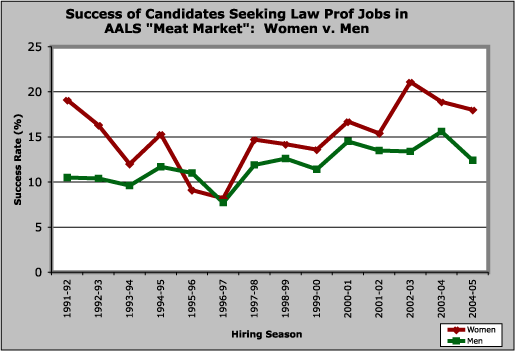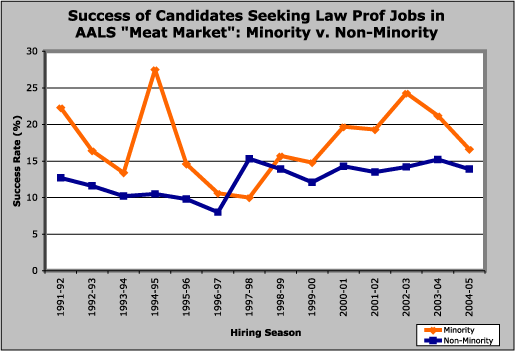For the last fourteen hiring seasons, the American Association of Law Schools (AALS) has collected data about how well the candidates listed in its Faculty Appointments Register did at finding academic jobs with law schools. (Presumably, those candidates got hired, if they did, after being interviewed at the AALS's annual Faculty Recruitment Conference, colloquially known as the "Meat Market.") The AALS has published that data in table form in its Statistical Report on Law School Faculty and Candidates for Law Faculty Positions (2005-06). I here recreate select portions of that data graphically, so as to better illustrate the relative success of women and non-Caucasian minorities.
This chart, using data from Table 13B of the Statistical Report, shows how well women have fared relative to men at landing jobs via the AALS faculty recruitment process:

This chart, using data from Table 13C, shows how well minorities have fared relative to non-minorities:

For a summary of how various types of candidates have done, on average, over the last 14 hiring seasons, consider this data, from Table 13E of the Statistical Report:
| Candidate Type | Success Rate (%) |
| Minority Women | 18.5 |
| Minority Men | 17.5 |
| Non-Minority Women | 15.0 |
| Non-Minority Men | 11.3 |
I could say a lot more about this data, adding caveats and analyses. I've written about the topic several times before, though, and don't want to tax anyone's patience by repeating myself. For some more recent blogging about the American Bar Association's causal role in these observed hiring trends, see Gail Harriot's recent series of posts.
I'll just say this, for now: Having gone through the meat market process three times, and having served for many years on my school's Appointments Committee, I find the relative success of males and non-minorities in the mid-to-late-90s the only surprising thing in the above data. Perhaps we can explain that divergence from the normal hiring pattern as an effect of the relatively tight job market in that era. Note, after all, that the percentage of all candidates hired, regardless of their sex, race, or ethnicity, hit all time lows around that time.
[Crossposted to Agoraphilia.]